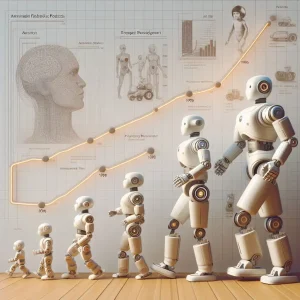From the first industrial robot arm in the 1950s to human-like androids today, the evolution of humanoid robots has been filled with scientific imagination and engineering ingenuity. This article takes us on an insightful journey to revisit the major milestones in the development of humanoid robotics, analyzing how each breakthrough built upon previous accomplishments to push the boundaries of what machines can do. Tracing the origins and growth of this technology, we can better understand and anticipate its shaping role in the future automation.Humanoid robots have gone through the following development stages:
Initial Stage (1950s-1960s)
In the 1950s, the first generation of industrial robots emerged, marking the beginning of the robotics era. Early robots were used for simple repetitive tasks in automated manufacturing, such as spraying, welding, and assembly.
In 1954, Unimation and General Motors collaborated to design and build the first industrial robot called Unimate. Unimate could only perform vertical arm movements to transfer parts or tools, and was used for welding in production lines. This marked the official introduction of first-generation robots with simple structures, fixed programming, and repetitive singular motions into the industrial domain.
In the 1960s, robots started to enter industrial sites and were more widely adopted in manufacturing production lines. In 1961, Unimate Installation carried out robotic welding operations at a General Motors plant in New Jersey, USA. After that, manufacturing industries gradually began using robots to replace human labor to improve production efficiency. The most extensively used robot in this period was the Spot Welding Robot specialized for spot welding.
Growth Stage (1970s-1980s)

In the 1970s, Japan took the lead in introducing robotic automation systems in automobile manufacturing, extensively using robots to improve production efficiency and reduce costs. This led to the rapid development of Japan’s automobile industry in the 1970s. By 1978, the number of industrial robots in Japan surpassed that in the United States, making it the world’s top robot-using country.
The capabilities of robots also kept improving during this period. In 1970, Victor Scheinman at Stanford University invented the “PUMA” robot. It featured an entirely new design with greater autonomy and flexibility, able to adjust actions based on environmental changes instead of just repeating pre-programmed motions. PUMA was known as the second-generation intelligent robot.
In the 1980s, robots made further advancements. In 1982, Siemens developed the SCARA robot capable of flexible wrist-like motions similar to the human hand. This robotic arm was widely used for precision tasks like electronics assembly. In 1983, RUGG first designed a six-legged multifunctional robot that could walk like an insect.
Prosperous Development Stage (1990s to Present)
Entering the 1990s, robotics experienced tremendous progress with expanding applications and more anthropomorphism.
In 1997, Hyundai Motor Company in Korea developed a robotic AGV system to automate welding, painting and other procedures. In the 21st century, Honda’s ASIMO became the first humanoid robot that could walk like a person. Sony’s QRIO was the first humanoid robot capable of expressing emotions.
After 2010, breakthroughs in AI technology brought new advances to robotics. Boston Dynamics’ Atlas robot, with outstanding performance in DARPA Robotics Challenge, achieved self-localization, dynamic balancing and environmental adaptation with superb mobility, and was considered the first true humanoid robot.
Today’s humanoid robots have been widely used in service industries, healthcare, household services and more. With continuous improvements in perception, learning abilities and interaction capabilities, humanoid robots are expected to assist human lives in more areas in the future.
Future Development Directions
Although humanoid robots have made remarkable progress, there are still various technological challenges to achieve truly human-like intelligence and autonomy:
- Mobility – Enable more flexible, compliant and agile whole-body motions.
- Environmental Perception – Improve perception and understanding of complex environments using various sensors.
- Interaction Capability – Achieve more natural and fluent voice interaction and understanding of human intent.
- Decision-Making – Make right decisions in complex environments.
- Learning Ability – Learn from experiences like humans, continuously optimize and improve.
With the advancement of AI, computer vision, sensing technologies, etc., future humanoid robots will have enhanced intelligence and play bigger roles in healthcare, household services, public security and more, becoming great helpers in human lives.
